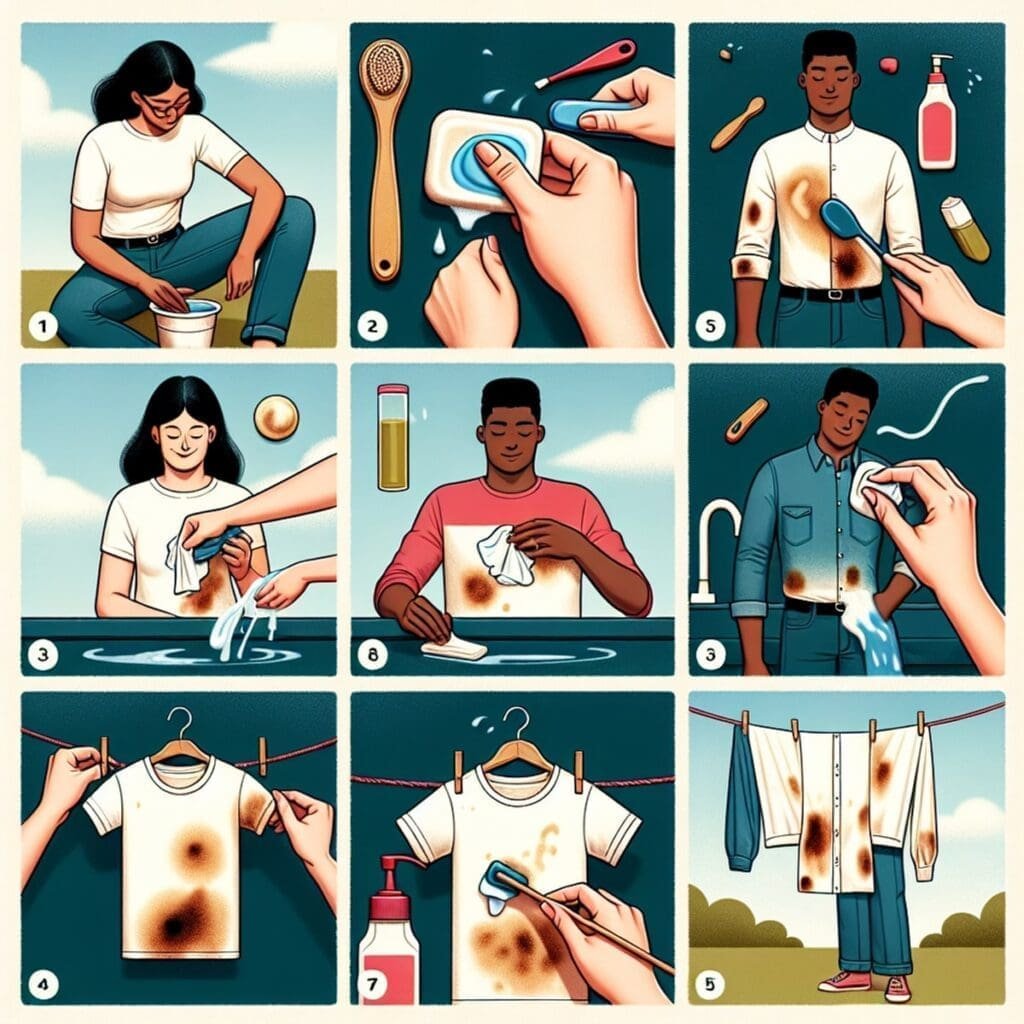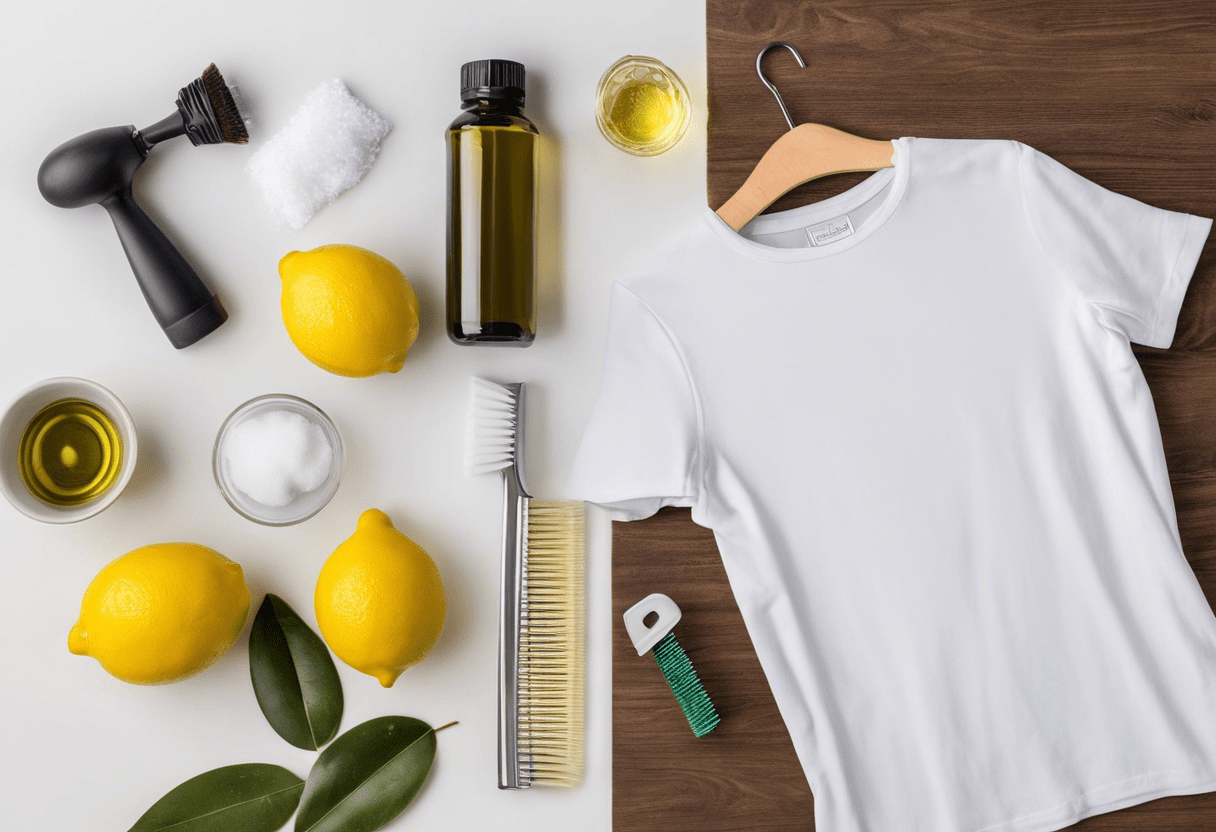
Introduction
Olive oil stains can be stubborn and challenging to remove from different types of materials such as fabric, carpet, wool, and cashmere clothing. It’s essential to take immediate action when dealing with olive oil stains to increase the chances of successful removal.
1. Methods for Removing Olive Oil Stains from Clothes

When it comes to removing olive oil stains from clothes, there are several effective methods you can try. Here are some stain removal tips to help you tackle those pesky oil marks:
1. Blotting the stain
Start by blotting the stained area with an absorbent material like paper towels or a clean cloth. This will help remove any excess oil and prevent it from spreading further into the fabric.
2. Using hand dishwashing soap
Apply a small amount of hand dishwashing soap directly to the stained area. Gently rub it in using your fingers or a soft brush to break down the grease. Allow the soap to sit on the stain for a few minutes before proceeding to the next step.
3. Laundry prewash stain remover or liquid laundry detergent
For more stubborn stains, you can use a laundry prewash stain remover or treat the stain with a small amount of liquid laundry detergent. Follow the instructions on the product label and make sure to test it on a small, inconspicuous area of the fabric first to avoid any potential damage.
4. Washing in hot water
Once you have treated the stain, it’s time to wash the garment. Check the care label instructions and wash the item in the hottest water temperature recommended for the fabric type. Hot water helps to break down and remove oil-based stains effectively.
5. Absorbing remaining oil
After washing, lay the fabric flat and cover any remaining oil stains with cornstarch or baking soda. These absorbent powders will help soak up any lingering oil residue. Allow them to sit on the fabric for at least 15 minutes before brushing them off.
6. Consider dry cleaning
If all else fails or if you’re dealing with delicate fabrics, such as silk or wool, that require special care, consider taking your garment to a professional dry cleaner. They have access to specialized dry cleaning solvents that can effectively remove oil stains without causing damage to the fabric.
7. Special care for delicate fabrics
For delicate fabrics like chiffon, which require extra caution, you can refer to vintage stain removal tips or seek guidance from experts on platforms like Quora. These resources offer specific techniques to handle oil stains on delicate materials.
By following these methods, you can increase your chances of successfully removing olive oil stains from your clothes. However, if the stain persists after trying these home remedies, it may be necessary to seek professional help or explore other stain removal options.
2. Removing Olive Oil Stains from Different Types of Fabric

Removing olive oil stains from different types of fabric can be a challenge, especially when dealing with delicate materials like wool and cashmere. Here are some tips to help you tackle these stubborn stains effectively:
Wool and Cashmere Clothing
Due to their delicate nature, it’s important to handle olive oil stains on wool and cashmere clothing with care. Avoid rubbing the stain, as this can push the oil deeper into the fibers and make it more difficult to remove. Instead, gently blot the stain with a clean cloth or paper towel to absorb as much oil as possible. If you’re unsure about how to proceed, this guide on wool stain removal can provide valuable insights.
White Vinegar
White vinegar is a natural alternative that can be used to remove olive oil stains from various types of fabric, including cotton, polyester, and linen. To use white vinegar for stain removal, follow these steps:
- Mix equal parts white vinegar and water in a spray bottle.
- Spray the solution directly onto the stained area.
- Gently blot the stain with a clean cloth or sponge.
- Rinse the fabric with cold water.
- Launder the garment as usual.
White vinegar helps break down the grease and oil in the stain, making it easier to remove during the washing process.
Remember, it’s always important to test any cleaning solution on a small, inconspicuous area of the fabric before applying it to the stain. This will ensure that there are no adverse effects on the fabric’s integrity.
By following these tips, you can effectively remove olive oil stains from different types of fabric, including delicate materials like wool and cashmere. However, if you’re dealing with other types of stains such as permanent marker stains or vintage stains, you may find it helpful to explore specific stain removal tips for those scenarios as well.
3. Pretreating and Washing Strategies for Olive Oil-Stained Clothes

When it comes to removing olive oil stains from clothes, pretreating the affected area is an essential step in ensuring successful stain removal. Here are some effective pretreating and washing strategies that you can follow:
- Pretreating with Dishwashing Detergent: Start by creating a mixture of warm water and liquid dishwashing detergent. Apply this solution directly to the olive oil stain and let it sit for a few minutes. The dishwashing detergent helps to break down the grease, making it easier to remove during the washing process.
- Checking the Care Label Instructions: Before proceeding with any cleaning method, it’s crucial to check the care label instructions on your garment. Different fabrics have specific requirements and limitations when it comes to cleaning. By following these instructions, you can avoid damaging the fabric while effectively removing the olive oil stain.
- Considering Fiber Content: Take into consideration the fiber content of your clothing when selecting appropriate cleaning methods. For example, delicate fabrics like silk, mohair, and leather require gentle treatment to prevent damage. In contrast, spandex and colored clothing may need extra care to preserve their color and shape.
- Choosing a Suitable Laundry Detergent: Selecting the right laundry detergent is key to effectively remove olive oil stains from clothes. Look for detergents that are designed to tackle tough stains, such as enzyme-based or grease-fighting formulas. If recommended, you can also use bleach-safe options like Clorox® Bleach for white garments.
- Guidelines for Washing Different Fabrics: To avoid any potential damage while removing stains, follow these specific guidelines:
- Colored Clothing: Machine wash in the hottest water temperature recommended for the fabric type using detergent suitable for colors like Clorox 2®.
- Spandex: Avoid using bleach or hot water, as these can damage the fabric. Instead, opt for a gentle cycle with cold or warm water.
- Silk: Hand wash using a mild detergent specifically formulated for silk. Gently agitate the fabric and avoid wringing or twisting.
- Mohair: Dry clean mohair garments to prevent shrinkage or distortion.
- Leather: Consult a professional cleaner who specializes in leather cleaning to ensure safe and effective stain removal.
By following these pretreating and washing strategies, you can increase the chances of successfully removing olive oil stains from your clothes while minimizing any potential damage to the fabric. Remember to always check the results before proceeding with drying to ensure complete stain removal.
4. Checking for Complete Stain Removal and Final Touches

After following the previous steps, it’s important to check if the olive oil stains have been completely removed before moving forward. Here’s what you can do:
- Inspect the garment in good lighting: Take a close look at the stained area under natural or bright light to see if any traces of the stain are still visible.
- Repeat the stain removal process if needed: If you notice any lingering stains, you can try repeating the previous steps or using an alternative method to target the remaining oil residue.
- Consider seeking professional help: For stubborn or delicate fabrics, it may be best to consult a professional cleaner who has experience dealing with oil-based stains.
- Air dry the fabric: Instead of using a dryer, it’s recommended to air dry the garment. This helps prevent any remaining oil residues from setting further into the fabric fibers.
Remember, prevention is key when it comes to dealing with olive oil stains. By acting quickly and using effective stain removal techniques, you can increase your chances of successfully removing these stubborn marks.
FAQs (Frequently Asked Questions)
What makes olive oil stains challenging to remove from different types of materials?
Olive oil stains can be stubborn and challenging to remove from different types of materials like fabric, carpet, wool, and cashmere clothing due to the greasy nature of the oil, which can penetrate and adhere to the fibers of the material, making it difficult to lift off.
What are some methods for removing olive oil stains from clothes?
Some methods for removing olive oil stains from clothes include blotting the stain with an absorbent material to remove excess oil, applying hand dishwashing soap directly to the stained area, using a laundry prewash stain remover or liquid laundry detergent, washing the garment in the hottest water recommended for the fabric type, and using absorbent materials like cornstarch or baking soda to further absorb any remaining oil.
How can olive oil stains be removed from different types of fabric such as wool and cashmere clothing?
Olive oil stains can be removed from different types of fabric like wool and cashmere clothing by blotting rather than rubbing on these delicate fabrics. Additionally, using white vinegar as a natural alternative can help in removing olive oil stains from various types of fabric like cotton, polyester, and linen.
What are some pretreating and washing strategies for olive oil-stained clothes?
Pretreating olive oil stains on clothes with a mixture of dishwashing detergent and warm water before rinsing is an effective strategy. It’s important to check the care label instructions and consider the fabric’s fiber content when choosing appropriate cleaning methods. Selecting a suitable laundry detergent for washing olive oil-stained clothes is crucial, and bleach-safe options can be used for white garments if recommended. Specific guidelines should be followed for washing colored clothing, spandex, silk, mohair, and leather items to avoid damage while removing stains.
How can one check for complete stain removal and apply final touches when dealing with olive oil stains?
To check for complete stain removal, it’s important to inspect the garment in good lighting to ensure that the olive oil stains have been completely removed before proceeding to dry it. If any traces of the stain are still visible, repeating the stain removal process or seeking professional help is recommended. Air drying the fabric instead of using a dryer is encouraged to prevent setting in any remaining oil residues. It’s important to stay proactive in dealing with olive oil stains and follow effective methods for their removal.







5 thoughts on “How to Get Out Olive Oil from Clothes: The Ultimate Guide”